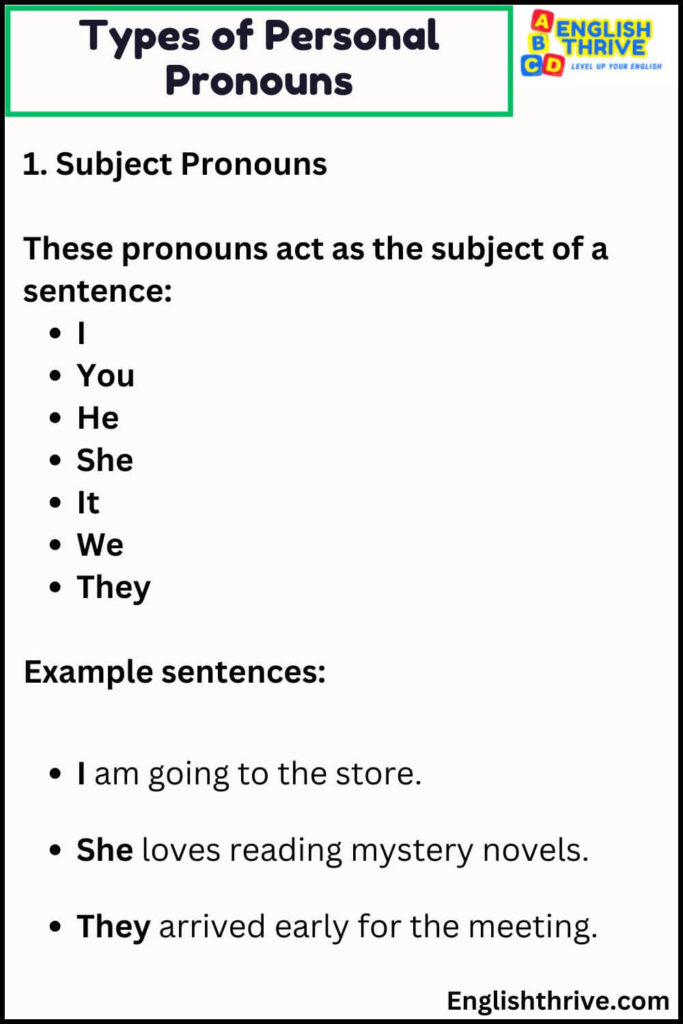Have you ever struggled to use personal pronouns correctly in your writing? You’re not alone! Personal pronouns are essential building blocks of English grammar that help us avoid repetitive language and make our sentences flow naturally. Let’s explore personal pronouns through clear examples and simple rules that will boost your confidence in using them.

Contents
ToggleUnderstanding Personal Pronouns
Personal pronouns are words that replace specific nouns in a sentence. Think of them as shortcuts that help us avoid saying the same names or things over and over. We use different types of personal pronouns depending on their role in a sentence.
Types of Personal Pronouns
1. Subject Pronouns
These pronouns act as the subject of a sentence:
- I
- You
- He
- She
- It
- We
- They
Example sentences:
- I am going to the store.
- She loves reading mystery novels.
- They arrived early for the meeting.
2. Object Pronouns
These pronouns receive the action in a sentence:
- Me
- You
- Him
- Her
- It
- Us
- Them
Example sentences:
- The teacher gave me helpful feedback.
- Sarah invited them to the party.
- Can you help us with this project?
3. Possessive Pronouns
These pronouns show ownership:
- Mine
- Yours
- His
- Hers
- Its
- Ours
- Theirs
Example sentences:
- This book is mine, not yours.
- The blue car is theirs.
- That opinion is hers alone.
4. Reflexive Pronouns
These pronouns refer back to the subject:
- Myself
- Yourself
- Himself
- Herself
- Itself
- Ourselves
- Themselves
- Yourselves
Example sentences:
- I hurt myself while cooking.
- The cat cleaned itself after dinner.
- They prepared themselves for the presentation.
138 Personal Pronoun Examples
Let’s look at a comprehensive table of personal pronoun examples:
| Subject Pronoun | Object Pronoun | Possessive Pronoun | Example Sentence |
|---|---|---|---|
| I | Me | Mine | I packed my lunch, and mine looks better than yours. |
| You | You | Yours | You left your phone at home, so take yours tomorrow. |
| He | Him | His | He improved his grades when we tutored him. |
| She | Her | Hers | She organized her desk, making hers the neatest. |
| It | It | Its | It broke its chain while pulling the cart. |
| We | Us | Ours | We submitted our project, making ours the first entry. |
| They | Them | Theirs | They painted their house, making theirs stand out. |
| I | Me | Mine | I completed my assignment before the deadline. |
| You | You | Yours | You must submit your report by Friday. |
| He | Him | His | He forgot his umbrella, so I lent him mine. |
| She | Her | Hers | She borrowed her sister’s car since hers was in repair. |
| It | It | Its | It chased its tail in circles. |
| We | Us | Ours | We shared our resources, benefiting all of us. |
| They | Them | Theirs | They improved their performance after training. |
| I | Me | Mine | I took my dog for a walk in the park. |
| You | You | Yours | You should bring your jacket; yours is warmer. |
| He | Him | His | He sent his application to multiple universities. |
| She | Her | Hers | She maintained her focus throughout the exam. |
| It | It | Its | It wagged its tail when seeing its owner. |
| We | Us | Ours | We decorated our office for the holidays. |
| They | Them | Theirs | They moved their furniture to their new house. |
| I | Me | Mine | I finished my work early today. |
| You | You | Yours | You should check your email regularly. |
| He | Him | His | He cleaned his room before going out. |
| She | Her | Hers | She practiced her presentation until perfect. |
| It | It | Its | It lost its way in the dark. |
| We | Us | Ours | We planned our vacation carefully. |
| They | Them | Theirs | They submitted their assignments on time. |
| I | Me | Mine | I brought my laptop to the meeting. |
| You | You | Yours | You can use your discount code now. |
| He | Him | His | He drove his car to work today. |
| She | Her | Hers | She wrote her story beautifully. |
| It | It | Its | It found its favorite toy under the couch. |
| We | Us | Ours | We shared our experiences with the group. |
| They | Them | Theirs | They improved their skills significantly. |
| I | Me | Mine | I prepared my presentation last night. |
| You | You | Yours | You should follow your dreams. |
| He | Him | His | He achieved his goals through hard work. |
| She | Her | Hers | She dedicated her time to volunteering. |
| It | It | Its | It protected its young from danger. |
| We | Us | Ours | We celebrated our success together. |
| They | Them | Theirs | They managed their time efficiently. |
Contextual Examples with Multiple Pronouns
Mixed Personal Pronouns in Professional Settings:
- “I gave him my report, and he shared his feedback with me.”
- “They presented their findings to us, and we incorporated them into our research.”
Personal Pronouns in Academic Context:
- “She submitted her thesis, and I reviewed it with my colleagues.”
- “We collaborated on our project while they worked on theirs.”
Personal Pronouns in Daily Life:
- “You left your keys at my house, so I brought them to you.”
- “He borrowed my car because his was at the mechanic.”
Personal Pronouns in Group Dynamics:
- “We shared our resources with them, and they appreciated our help.”
- “I joined their team, and they welcomed me warmly.”
Personal Pronouns in Family Settings:
- “She helped her sister with her homework until it was complete.”
- “They visited their grandparents, and we met them there.”
Common Rules for Personal Pronouns
Subject-Verb Agreement
- Always match your pronoun with the correct verb form:
- He runs (not run)
- They run (not runs)
Case Agreement
- Use subject pronouns for subjects
- Use object pronouns after prepositions
- Use possessive pronouns to show ownership
- Gender Neutrality
- Use “they” as a singular pronoun when gender is unknown
- Respect preferred pronouns in professional and personal communication
FAQs about Personal Pronouns Examples Definition with Clear Explanations
1. How do you identify personal pronouns in a sentence?
To identify personal pronouns in a sentence, look for words that replace specific nouns. They usually refer to:
- The person speaking (I, me, my, mine)
- The person being spoken to (you, your, yours)
- The person or thing being spoken about (he, she, it, they, him, her, them)
For example, in the sentence “Sarah gave her book to me,” both “her” and “me” are personal pronouns replacing the nouns “Sarah” and the speaker, respectively.
2. What’s the difference between its and it’s?
“Its” is a possessive pronoun showing ownership, while “it’s” is a contraction of “it is” or “it has.” Here’s how to remember:
- Its: The dog wagged its tail. (showing possession)
- It’s: It’s raining outside. (meaning “it is”)
3. When should I use who versus whom?
Use “who” as a subject pronoun and “whom” as an object pronoun. Here’s a simple trick:
- If you can replace it with “he/she,” use “who”
- If you can replace it with “him/her,” use “whom”
Example:
- Who wrote this letter? (He/she wrote this letter)
- To whom should I address this package? (Address this package to him/her)
4. Can they be used as a singular pronoun?
Yes, “they” can be used as a singular pronoun in two main cases:
- When referring to someone whose gender is unknown
- When someone’s preferred pronoun is “they”
Example: “If anyone needs help, they should raise their hand.”
5. How do you fix pronoun agreement errors?
To fix pronoun agreement errors:
- Identify the antecedent (the noun the pronoun replaces)
- Check if the pronoun matches in:
- Number (singular/plural)
- Gender
- Person (first, second, or third)
Example:
- Incorrect: “Everyone should bring their books.”
- Correct: “Everyone should bring his or her book.”
Conclusion
Understanding personal pronouns doesn’t have to be complicated. With these examples and rules, you can use them confidently in your writing and speaking. Remember to consider context, maintain agreement, and practice regularly. The more you use personal pronouns correctly, the more natural they’ll become in your everyday communication.

